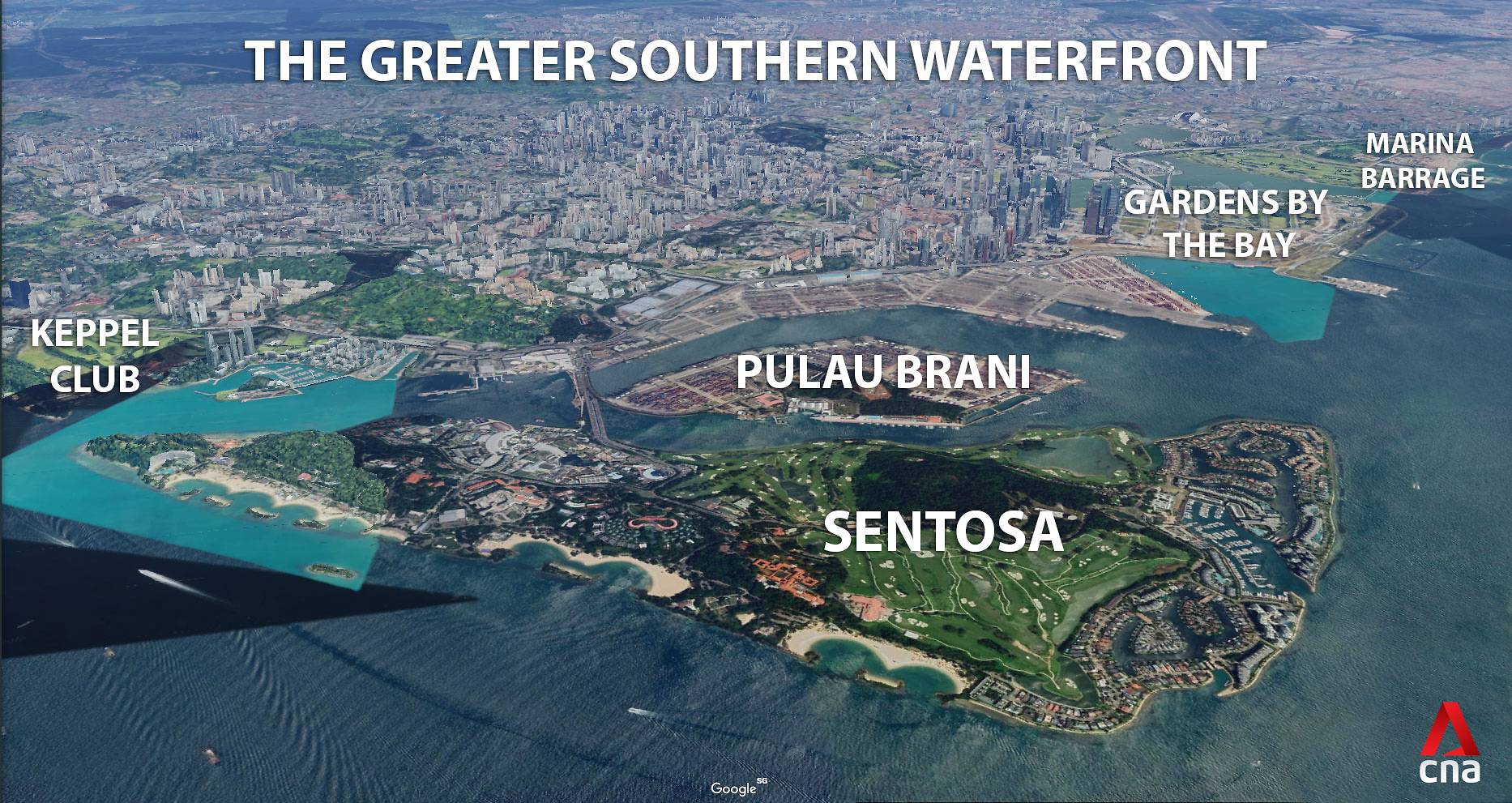SINGAPORE: It’s always been there.
But rarely has Pulau Brani made the headlines in recent years, until it became a significant part of Singapore’s plans to develop the Greater Southern Waterfront.
On Sunday (Aug 18), Prime Minister Lee Hsien Loong gave an overview of the revamp that’s in store for the island during his National Day Rally speech.
READ: Sentosa Island, Pulau Brani development plans in the works
Currently home to the Brani Terminal, which opened in 1992, the island will be redeveloped to host a range of lifestyle and tourist attractions – similar to what can be found next door in Sentosa.
As Pulau Brani awaits a new future, a look back in time at how the island evolved.
Artist’s impression featuring a bird’s eye view of the developments on Sentosa and Pulau Brani, under the Sentosa-Brani Master Plan. (Photo: Sentosa Development Corporation)
ISLAND OF THE BRAVE
Situated between the main island’s southern coast and Sentosa, Pulau Brani means “island of the brave” in Malay. In years gone by, it was also known as Pulau Ayer Brani and Pulo Brani.
In Cantonese, it was referred to as San chu-shek tui-min, which means opposite the new tin smelting and chha-tin ma-thau tui-min, which means opposite Jardine’s jetty.
Consisting mainly of fisherfolk, the island hosted four main villages – Telok Saga, Selat Sengkir, Masak Timah and Spedo – which later made way for development.
As part of early development by the British in the mid-19th century, Pulau Brani hosted a brick factory and a yard for repairing small boats. This was the brainchild of Charles Prinsep from the East India Company who also owned a nutmeg plantation in Singapore in what is today Prinsep Street.
FORT TEREGAH
The brick factory and the yard did not last long after the government re-purposed the island for defensive needs. A small repair dock for British naval vessels was then built.
In 1861, Fort Teregah, consisting of a coastal battery with two 64-pounder rifled muzzle loading guns, was established on the southeast of Pulau Brani to bolster Singapore’s defences.
Four years later, a naval coal depot was built, consisting two coal sheds, a small house and a wooden pier.
More developments on the island followed a year later, when a small dock for ship repair was built on the west of the island.
TIN SMELTING PLANT
Towards the end of the 19th century, a Western-style tin-smelting plant was built on the island by the Straits Trading Company that eventually led to the production of “Straits Tin” which became highly regarded internationally.
The construction of the smelter began right after the incorporation of the company – a joint venture by German businessman Herman Muhlinghaus and Scottsman James Sword – in 1887.
The duo decided on Pulau Brani as an ideal location for their new smelter with construction completed in about two years.
Operations expanded quickly.
READ: New attractions, housing and office spaces to be developed in Greater Southern Waterfront
By 1895, the plant had 12 furnaces in operation and was capable of producing 14,000 tonnes of tin a year. The rapid progress pushed the company to modernise the plant. This led to the replacement of the coal-firing furnaces with 15 gas-fired ones that were larger.
By the beginning of the 20th century, Pulau Brani was home to the production of the purest-quality tin that was shipped and sold across the world.
Despite the success, tin production was severely hit as the Straits Company struggled to ride the storms of the two world wars, the Great Depression and the impact on demand in the first half of the 20th century.
Prior to the Japanese invasion, European technicians destoyed the smelter for fear of it being used by the invaders. But it was brought back into service after World War II, only for operations to wind down by 1965.
In 1971, the Singapore Government took over the site of the smelter and built Singapore’s first naval base.
BRANI NAVAL BASE
The Brani Naval Base was officially opened on Jan 26, 1974 by then Prime Minister Lee Kuan Yew.
Costing about S$35 million, it was referred to as the Maritime Command Base and was expanded in 1983 with the addition of a second wharf.
The island was deemed ideal because of its central location from which navy ships could be deployed across the Singapore Strait.
Ships could now be berthed in close proximity to the operational headquarters. Previously, ships were secured offshore, with the headquarters located at Pulau Blakang Mati, known today as Sentosa.
It was at Brani Naval Base that the Republic of Singapore Navy commissioned its first missile gunboats which were acquired from Germany.
Due to its limited area, it was announced in 1990 that the Brani Naval Base operations would eventually move to Tuas and Changi.

BRANI TERMINAL
A year after that announcement, a 330-metre causeway was constructed to link Pulau Brani to the mainland.
This was followed by the official opening of Brani Terminal in 1992 which was attended by then Prime Minister Goh Chok Tong.
The S$1.14 billion container terminal was part of an expansion of port facilities in the decade.
Singapore port operator, PSA has been conducting relocation operations from Brani and Keppel to the newer Pasir Panjang Terminal with eventual consolidation – along with Tanjong Pagar terminal – to the Tuas megaport.
After more than 27 years in operation as a port terminal, Pulau Brani is set to be revamped once more as it continues to evolve with the times.




